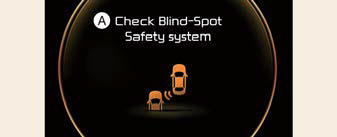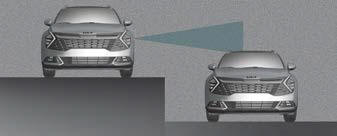Kia Sportage: Blind-Spot Collision-Avoidance Assist malfunction and limitations

- Check Blind-Spot Safety system
When Blind-Spot Collision-Avoidance
Assist is not working properly, the warning message will appear on the cluster
for several seconds, and the master
warning light ( ) will appear. Have
Blind-Spot Collision-Avoidance Assist be
inspected by an authorized Kia dealer.
) will appear. Have
Blind-Spot Collision-Avoidance Assist be
inspected by an authorized Kia dealer.
A: Check side view mirror warning light
When the outside rear view mirror warning
light is not working properly, the
warning message will appear on the
cluster for several seconds, and the
master warning light ( ) will
appear.
) will
appear.
Have Blind-Spot Collision-Avoidance Assist be inspected by an authorized Kia dealer.
Blind-Spot Collision-Avoidance Assist disabled

A: Blind-Spot Safety system disabled.
Radar blocked
When the rear bumper around the rear corner radar or sensor is covered with foreign material, such as snow or rain, or installing a trailer or carrier, it can reduce the detecting performance and temporarily limit or disable Blind-Spot Collision- Avoidance Assist.
If this occurs, a warning message will appear on the cluster. However it is not a malfunction.
Blind-Spot Collision-Avoidance Assist will operate normally when such foreign material or trailer, other equipments is removed, and then the vehicle is restarted. Always keep it clean.
If Blind-Spot Collision-Avoidance Assist does not operate normally, check the vehicle's rear luggage, other equipment, or foreign material is removed. After ensuring no foreign material or equipment, Blind-Spot Collision-Avoidance Assist should be checked by an authorized Kia dealer.
WARNING
- Even though the warning message does not appear on the cluster, Blind- Spot Collision-Avoidance Assist may not properly operate.
- Blind-Spot Collision-Avoidance Assist may not properly operate in an area (e.g. open terrain) where any substances are not detected right after the vehicle is turned on, or when the detecting sensor is blocked with foreign material right after the vehicle is turned on.
CAUTION
Turn off Blind-Spot Collision-Avoidance Assist to install a trailer, carrier, etc., or remove the trailer, carrier, etc. to use Blind-Spot Collision-Avoidance Assist.
Limitations of Blind-Spot Collision- Avoidance Assist
Blind-Spot Collision-Avoidance Assist may not operate normally as following circumstances:
- There is inclement weather, such as heavy snow, heavy rain, etc.
- The rear corner radar is covered with snow, rain, dirt, etc.
- The temperature around the rear corner radar is high or low
- The rear corner radar is covered by vehicle or pillar, walls etc.
- Driving on a highway (or motorway) ramp and tollgate.
- The road pavement (or the peripheral ground) abnormally contains metallic components (i.e. possibly due to subway construction).
- There is a fixed object near the vehicle, such as sound barriers, guardrails, double guardrails, central dividers, entry barriers, street lamps, signs, tunnels, walls, etc. (including double structures)
- Driving through a narrow road where trees or grass are overgrown
- Driving in large areas where there are few vehicles or structures (i.e. desert, meadow, suburb, etc.)
- Driving on a wet road surface, such as a puddle on the road
- The other vehicle drives very close behind your vehicle, or the other vehicle passes by your vehicle in close proximity
- The speed of the other vehicle is very fast that it passes by your vehicle in a short time
- Your vehicle passes by the other vehicle
- Your vehicle changes lane
- Your vehicle has started at the same time as the vehicle next to you and has accelerated
- The vehicle in the next lane moves two lanes away from you, or when the vehicle two lanes away moves to the next lane from you
- A trailer or carrier is installed around the rear corner radar
- The bumper around the rear corner radar is covered with objects, such as a bumper sticker, bike rack, etc.
- The bumper around the rear corner radar is impacted, damaged or the radar is out of position
- Your vehicle height is low or high due to heavy loads, abnormal tire pressure, etc.
Blind-Spot Collision-Avoidance Assist may not operate normally, or it may operate unexpectedly when the following objects are detected:
- A motorcycle or bicycle is detected
- A vehicle such as a flat trailer is detected
- A big vehicle such as a bus or truck is detected
- A moving obstacle such as a pedestrian, animal, shopping cart or a baby stroller is detected
- A vehicle with low height such as a sports car is detected
Braking control may not work as following circumstances:
- The vehicle severely vibrates while driving over a bumpy road, uneven road or concrete patch
- Driving on a slippery surface due to snow, water puddle, ice, etc.
- The tire pressure is low or a tire is damaged
- The brake is reworked
- The vehicle makes abrupt lane changes
NOTICE
For more details on the limitations of the front view camera, refer to "Forward Collision- Avoidance Assist (FCA) (Front Camera Only) (if equipped)" and "Lane Keeping Assist (LKA)"
WARNING
Driving on a curved road
 Blind-Spot Collision-Avoidance Assist
may not operate properly when driving
on a curved road. Blind-Spot Collision-
Avoidance Assist may not detect
the vehicle in the next lane.
Blind-Spot Collision-Avoidance Assist
may not operate properly when driving
on a curved road. Blind-Spot Collision-
Avoidance Assist may not detect
the vehicle in the next lane.
Always pay attention to road and driving conditions while driving.
 Blind-Spot Collision-Avoidance Assist
may not operate properly when driving
on a curved road. Blind-Spot Collision-
Avoidance Assist may detect a
vehicle in the same lane.
Blind-Spot Collision-Avoidance Assist
may not operate properly when driving
on a curved road. Blind-Spot Collision-
Avoidance Assist may detect a
vehicle in the same lane.
Always pay attention to road and driving conditions while driving.
- Driving where the road is merging/ dividing
 Blind-Spot Collision-Avoidance Assist
may not operate properly when driving
where the road merges or divides.
Blind-Spot Collision-Avoidance Assist
may not operate properly when driving
where the road merges or divides.
Blind-Spot Collision-Avoidance Assist may not detect the vehicle in the next lane.
Always pay attention to road and driving conditions while driving on the road merges or divides.
- Driving on a sloped road
 Blind-Spot Collision-Avoidance Assist
may not operate properly when driving
on a sloped road. Blind-Spot Collision-
Avoidance Assist may not detect
the vehicle in the next lane or may
incorrectly detect the ground or structure.
Blind-Spot Collision-Avoidance Assist
may not operate properly when driving
on a sloped road. Blind-Spot Collision-
Avoidance Assist may not detect
the vehicle in the next lane or may
incorrectly detect the ground or structure.
Always pay attention to road and driving conditions while driving.
- Driving where the heights of the lanes are different
 Blind-Spot Collision-Avoidance Assist
may not operate properly when driving
where the heights of the lanes are
different. Blind-Spot Collision-Avoidance
Assist may not detect the vehicle
on a road with different lane heights.
Blind-Spot Collision-Avoidance Assist
may not operate properly when driving
where the heights of the lanes are
different. Blind-Spot Collision-Avoidance
Assist may not detect the vehicle
on a road with different lane heights.
Always pay attention to road and driving conditions while driving.
WARNING
- When you are towing a trailer or another vehicle, make sure that you turn off Blind-Spot Collision-Avoidance Assist.
- Blind-Spot Collision-Avoidance Assist may not operate normally if interfered by strong electromagnetic waves.
- Blind-Spot Collision-Avoidance Assist may not operate for approximately 15 seconds after the vehicle is started, or the front view camera or rear corner radars are initialized.
This device complies with Part 15 of the FCC rules.
Operation is subject to the following two conditions:
- This device may not cause harmful interference, and
- This device must accept any interference received, including interference that may cause undesired operation.
READ NEXT:
 Safe Exit Warning settings
Safe Exit Warning settings
After the vehicle stops, when an
approaching vehicle from the rear area
is detected as soon as a passenger
opens a door, Safe Exit Warning will
warn the driver with a warning message
and an a
 Safe Exit Warning operation
Safe Exit Warning operation
Warning
Safe Exit Warning warns the following
actions.
Collision warning when exiting vehicle
Watch for traffic
The warning light on the side view
mirror will blink and the warn
SEE MORE:
 Scheduled maintenance service
Scheduled maintenance service
Scheduled maintenance service precaution
Follow the Normal Maintenance Schedule
if the vehicle is usually operated
where none of the following conditions
apply. If any of the following conditions
apply, follow the Maintenance Under
Severe Usage Conditions.
Repeated driving short distance o
 Repair method for PP bumper
Repair method for PP bumper
Damage to the bumper that reaches the surface of the polyporpylene cannot be
fixed just by painting. Use the repair
methods shown below to repair damage that reaches the surface of the
polypropylene.
1. Rough cut the damaged area 45º using a
knife and then sand the angle smooth.
2. W
Content
- Home
- Kia Sportage - Fifth generation (NQ5) - (2022-2025) - Owner's Manual
- Kia Sportage - Second generation (JEKM) (2005-2015) - Body Workshop Manual
- Kia Sportage Third generation (SL) - (2011-2016) - Service and Repair Manual
- Sitemap
- Top articles